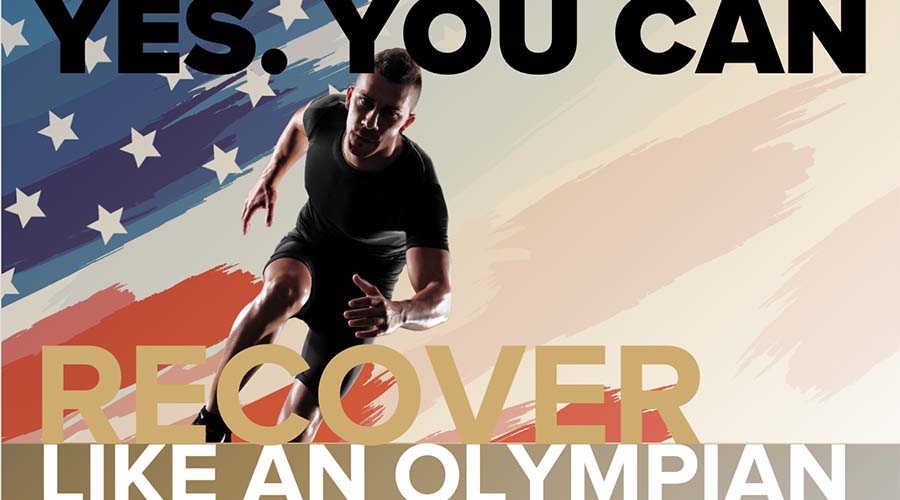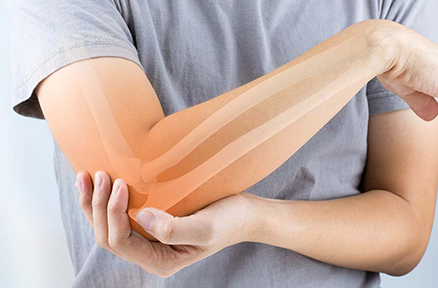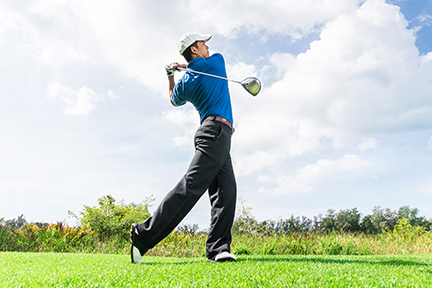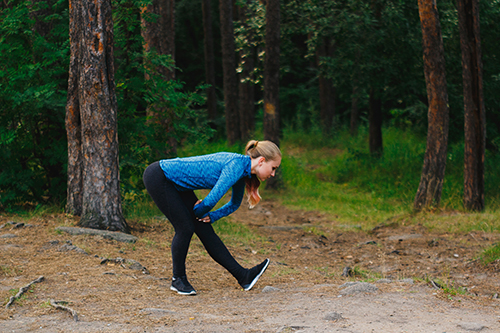RECOVER LIKE AN OLYMPIAN.
When Competition Day Is Looming.
When every missed game is a hit to the team, there is enormous pressure on an injured athlete to get back to competition as quickly and safely as possible. A sports medicine team includes physicians, athletic trainers, physical therapists, and others. All these roles work together to guide the athlete through recovery back into their game – stat!
In the Tokyo Olympics 2020/2021, USA Women’s Volleyball “opposite” Jordan Thompson rolled her ankle on a bad landing from a blocking jump. An ankle “roll” is a sideways twist that stretches or tears one or more of the ankle ligaments and can range from very mild to extremely severe. Luckily Jordan’s injury did not keep her from the quarterfinals and she was soon back on court with the 12-Strong. She even thanked her trainer on Instagram posting “thank you to our trainer @kara_kessans for a kick butt treatment plan!”
What might that treatment plan have been?
Read on to learn more about how to recover like an Olympian when time is not on your side.
IMMEDIATE CARE – DAMAGE CONTROL
You’ve probably seen trainers or therapists sprinting out from the sidelines to an athlete who has gone down on the field. That’s how important it is to administer treatment immediately. Depending on the injury, the trainer may be pressing on the injury, applying compression to stop bleeding, or they may splint the injury if they see a broken bone or misshapen joint. In the many cases where the injury is a soft tissue injury, the immediate treatment is to apply ice to manage the inflammatory response.
WHY ICE WORKS SO WELL ON SOFT TISSUE INJURIES
There are a few (not many) critics of the icing regimen, but the fact is that ice works on multiple levels for the treatment of soft tissue injuries such as muscle, tendon and ligament pulls or tears. When a tissue is traumatized by an impact or over-stretching, the damage causes an inflammatory response in the body (“inflammation”). This is the body’s version of sending a clean-up crew after a disaster. Products which are the equivalent of first responders arrive at the injury site and begin to clean up dried blood and damaged tissue and such. When the injury area becomes red, warm and tender, that’s the inflammatory response at work – already cleaning up the damage.
Sometimes the body isn’t sure how big the clean-up crew should be, and the inflammatory chemicals need some ‘policing’. Icing is the inflammatory police – it slows down the inflammatory response so that the clean-up crew doesn’t do too much damage. Ice also acts as a numbing agent by slowing down the rate at which the nerves fire off pain signals. Therefore, icing an injury can reduce pain while it is being applied and for a short time afterwards.
Finally, ice can assist in blood flow to an injury once the ice pack is removed. While ice is applied, blood flow is reduced, but once it is removed, blood rushes back to the injury carrying much needed oxygen and nutrients.
Though simple and straightforward, cooling an injury to control pain and slow down the inflammatory response is a key part of a world class athlete’s strategy in minimizing the impact of an injury. Typically, ice will be applied in a 20-minutes-on/20-minutes-off regimen at least four times per day for 72 hours. Beyond that, it may be used when pain or swelling returns.
WHAT IS RICE AND Ps? (IT’S NOT DINNER)
The acronym R-I-C-E is well known these days for Rest-Ice-Compression-Elevation: four activities for the immediate care of musculoskeletal injuries. The “P” was added later by the therapy profession for “Protection”, which is recognition that some injuries need a splint or sling to protect the body part from further injury. “Protection” includes not only splints and slings, but can include bandages, wraps, walker boots, crutches, canes and so on, which are all referred to as “Durable Medical Equipment” (DME). Top level athletes ensure that they have all the DME that they need for their various phases of recovery.
Athletes will follow the RICE + P regimen pretty much universally, as directed by their sports med team. As well as the “C” of compression (applying a static bandage to control swelling and protect the area), many recovery professionals have added intermittent compression to their treatment plans.
WHAT’S SPECIAL ABOUT INTERMITTENT COMPRESSION?
When an injury occurs to soft tissue such as an ACL tear or an Achilles tendon injury, the swelling that results is clinically referred to as “edema”. Post-injury edema contains those clean-up agents that we referred to earlier – white blood cells, proteins and antibodies to help clear waste tissue and start rebuilding new tissue. Edema can cause pain by pressing on the nerves in the area. It also takes up space, which can restrict joint movement (such as bending a knee) which in turn makes it harder to exercise.
In the cases of lower limb edema, a normal calf muscle would be able to “pump” edema out of the injury site back into the lymph system after which it can eliminated by the body’s natural movement. When the leg is injured and the calf muscle is not able to be worked through walking or running, Olympic trainers often turn to mechanical devices to simulate a natural muscle contraction, an activity known as intermittent compression. Manual drainage therapy can also assist removal of edema. When you hear about elite athlete massage, it’s not necessarily aromatherapy at a local spa!
NSAIDS
While ice can be very effective at reducing pain and swelling, cold therapy may be supplemented by Non-Steroidal-Anti-Inflammatory Drugs (NSAIDs). These may be helpful in the early days of an injury when pain levels are still problematic.
THE HEAT IS ON
Later in the recovery process, approximately 10 days+ after an injury, some elite athletes move over from cold therapy to heat therapy. Where cold reduces blood flow, heat increases it. Using a heat wrap, athletes may receive a 20 minute or more heat treatment which is intended to improve tissue flexibility and increase fuel supply to the injury site. Physical therapists in local clinics use the same technology as the pros use – a heating device which use hot water to warm a soft pad, which is then wrapped in soft towels. This device, known as a “hydrocollator” gives a comfortable, soothing form of heat therapy.
INJECTIONS
In the innovative area of orthobiologics, naturally occurring healing agents may be injected into the injury site to stimulate healing. Pro athletes turn to these procedures when they wish to accelerate repair of tendons and/or when there is some degeneration in the tissue which they wish to overcome. For more information on these types of treatments, visit GSOS’s orthobiologics website .
PHYSICAL THERAPY
Exercise and movement are important following injury or surgery. Muscle contractions through exercise release nitric oxide which decreases inflammation, aids in wound healing and helps prevent stiffness. Exercise increases blood flow which improves the supply of oxygen and nutrients to an injury, both of which are important in tissue healing.
SURGERY
Surgeries for sports injuries are almost always arthroscopic, which is a procedure using a pencil-sized instrument that contains a small lens and lighting system to magnify and illuminate the structures inside the joint. Light is transmitted through fiber optics to the end of the arthroscope that is inserted into the joint.
By attaching the arthroscope to a miniature camera, a surgeon is able to see the interior of the joint through this very small incision, rather than the larger incision used in open surgery.
Arthroscopic surgeries are usually out-patient so the athlete can go home the same day. The goal of this form of surgery is to minimize three things: 1) the size of the incision, 2) pain levels and 3) recovery time. Of course, more conservative approaches are used first, but if needed an athlete may be recommended for surgery.
It’s important when recovering like an Olympian to find a clinic which offers a continuum of care – where doctors, nurses and physical therapy staff are in close contact with each other to understand the athlete’s complete situation, including overall health, prior injuries and so on.
A WHOLE PERSON APPROACH
Elite athletes know that it’s not just the injury itself that needs TLC for a better recovery. The body needs good quality fuel and restorative sleep for the fastest recovery. A fast recovery requires a champion’s mindset to ensure that the recovery process is embraced with dedication and a positive attitude.
SLEEP
Sleep is an important component of athletic and injury recovery. Sleep allows the body the time it needs to recover, repair and boost immune function. The science of good sleep is relatively well known. As a person falls into the deeper stages of sleep, muscles experience an increase in blood flow, resulting in improved oxygen and nutrients that help to repair them and regenerate cells.
Hormones come into play too. When the body enters its deep sleep stage, the pituitary gland releases growth hormones that stimulate muscle repair and growth. When the body doesn’t get enough rest, the secretion of this growth hormone declines, and it can become more difficult to recover quickly from injuries.
The hormone prolactin, which helps regulate inflammation, is also released while sleeping. Without enough sleep, an athlete may experience increased inflammation in the body, which can make injury recovery more challenging, as well as increasing risk of further injury.
NUTRITION
There has been so much debate over the most effective diets for optimal health – Atkins, Vegan, Pegan, you name it, there is probably a nutritional plan named after it. At a high level, most athletes understand the role of nutrition in athletic performance generally and will have optimized their diet for their own metabolism, training load and competition schedule.
For recovery specifically, elite athletes will have a balanced intake of healthy carbs, protein, essential fatty acids and micronutrients as well as healthy fluids (non-sugary drinks) during recovery. Their diet may be adapted for repair and reconstruction of tissue and/or bone.

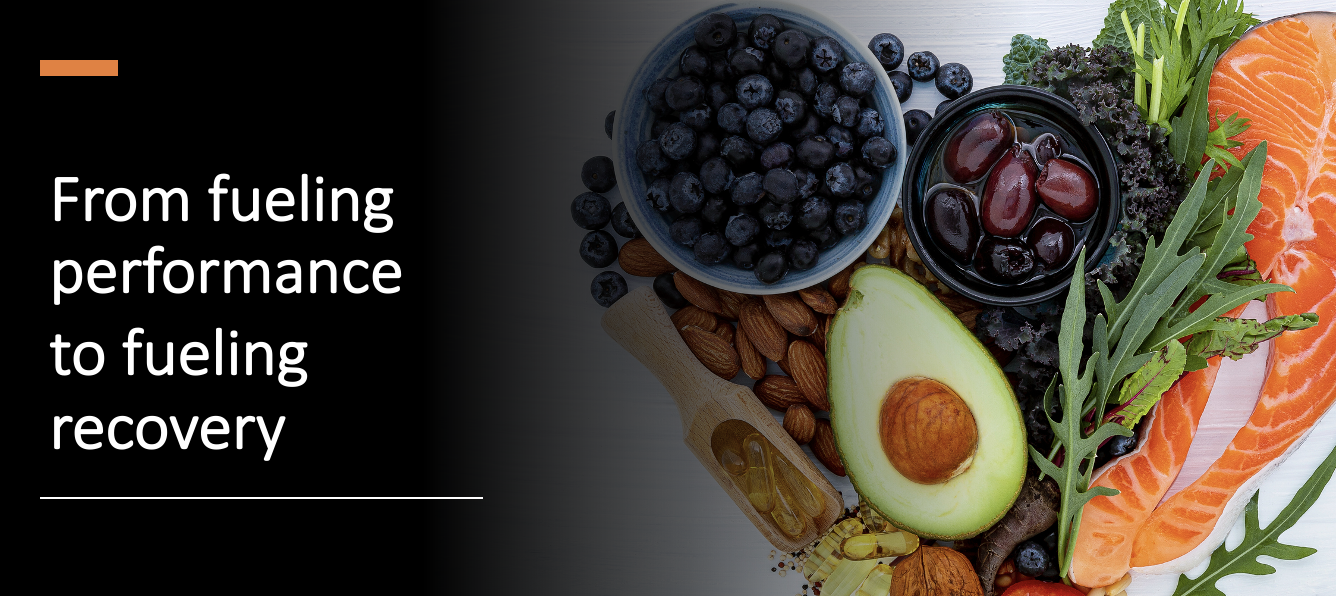
“For an athlete recovering from injury, the nutrition emphasis shifts from fueling performance to fueling recovery” says Dr Matthew Pecci, sports medicine specialist at Muir Ortho. “During injury recovery, the body is battling inflammation so increasing the number of anti-inflammatory foods, while decreasing the amount of pro-inflammatory foods is helpful.”
According to the National Athletic Trainers Association (NATA),
“Optimal nutrition can play a key role in controlling inflammation, providing key nutrients for rebuilding injured tissue … and supporting strength preservation and gain.”
Some of NATA’s recommendations to Olympic trainers for their injured athletes include consumption of
Leucine-rich Proteins
- Cheese; swiss, provolone, colby, mozzarella
- Meat: pork, chicken
- Fish: tuna, trout, salmon
- Nuts and seeds: soybeans, pumpkin, peanuts, almonds
- Tempeh (fermented soybeans available in block or strips)
Anti-oxidant rich fruit and vegetables
- Blueberries
- Cranberries
- Tart cherry
- Artichoke
- Kidney beans
Anti-inflammatory Fats
- Swap out pro-inflammatory fats (fried foods and processed meats) for anti-inflammatory fats (olive oil, avocado oil, fish oil, flax oil).
Micro-nutrients
- Calcium and Vitamin D
- Iron
- Vitamin C
- Electrolytes
Our sports medicine teams welcome conversations about nutrition to support healing. You can also consult with your primary care physician about further sources of nutritional advice.
THE MENTAL GAME
It’s not just golf that is played in your head … injury recovery is a mental game too. It helps to have a disciplined mindset to perform the exercises and activities set by your sports med team. Athletes know that the more they give, the more they get and so they commit to recovery as a daily discipline.
Outside the competitive sports environment, we often don’t follow the good-for-us routines because it’s just so easy not to. When you are not in the mood for recovery exercises, you might find this thought helpful:
Great athletes just do it. Being ‘in the mood’ comes after you’ve started.
Laura Davis is a Nurse Practitioner on the Muir Ortho Sports Medicine Team. As a 3-time US Olympic Trials finalist in swimming, Laura knows what it takes to recover like an Olympian. As a member of the US National Swim Team, Laura missed the Olympics by 1/10th of a second. According to Laura
“In sports, timing is everything, and in recovery it is too!”


It is critical for world class athletes to follow the treatment plan provided to them by their sports med team. We have all heard about cases where an athlete went back too soon, only to immediately sustain the same injury – but this time significantly more severely. Physical therapists and sports medicine doctors and their teams can assess an individual’s capacity to return to specific sports and activities – safely. Physical therapy protocols help individuals gradually build back up their strength, agility, balance and so on, with continuous assessment along the way. As we hear from Laura in her video, there’s one gold medal tip to successful recovery!
ABOUT GOLDEN STATE ORTHO SPORTS MEDICINE
Fortunately for Bay Area athletes, whether pro team athletes or weekend warriors, the sports medicine team at Golden State Orthopedic & Spine is game ready and on your side!
Whether you just want to move without pain, or you want to get back in the game, we have advanced diagnostics, treatments and therapies to help you get back – better.

